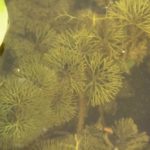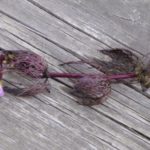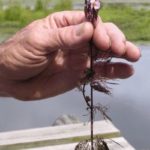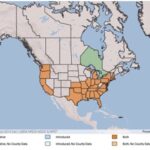Cabomba spp.
Illustration courtesy of University of Florida/IFAS Center for Aquatic and Invasive Plants. Used with permission.
What is Fanwort, Cabomba?
Physical Characteristics
Leaves: two types
Floating:
- Alternate
- Leaf blade linear or oval-shaped
Flowers:
- Single flower at end of long
- At or above water surface
- Usually 3 sepals
- Usually 3 petals
- Petals alternate with sepals
- 3-36 stamen
- Short anthers
Fruit:
- Does not open to release the seeds when ripe
- Leathery texture
- 1-3 seeded
Stems:
Roots:
- Rooted in mud
Where Does it Grow?
USDA, NRCS. 2018. The PLANTS Database (http://plants.usda.gov, 28 March 2018). National Plant Data Team, Greensboro, NC 27401-4901 USA.
Fanwort can be found in lakes, ponds, and quiet streams.
Pros and Cons of Fanwort
Fanwort has little known direct food value to wildlife. Submerged portions of all aquatic plants provide habitats for many micro and macro invertebrates. These invertebrates in turn are used as food by fish and other wildlife species (e.g. amphibians, reptiles, ducks, etc.). After aquatic plants die, their decomposition by bacteria and fungi provides food (called “detritus”) for many aquatic invertebrates.
What Type of Fanwort Do I Have?
There are 2 common species of fanwort in North America. Click on the buttons to learn more about each species.








